Brief introduction of Lipa City
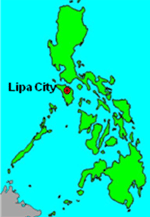
Lipa is an inland urban growth hub not only for the Batangas Province, but also for the National Capital- Region, experiencing in-migrating economic investment with a significant number of new commercial and residential businesses being established in recent years, with a population of 218,447 in 2000.
Visually dominated by Mt Malarayat, Lipa is situated at an elevation of 1,025 feet above sea level with a predominantly agricultural economy based upon coffee, hog and poultry farming. The city consists of 72 barangays, 12 of which are in the poblacion (city proper) and 60 are suburbs. The Mayor, elected by direct majority vote, is the Chief Executive. A City Council, comprising of elected City Councilors, serves as the legislature.
Sustainable Lipa Project (SLP)
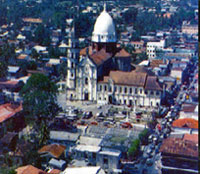
The Sustainable Cities Programme was implemented in the Philippines through the "Strengthening Local Environmental Planning and Management" (L-EPM) Project by the Department of Environment and Natural Resources (DENR), and the League of Cities in the Philippines (LCP). The Project was established to strengthen the Local Government Units (LGUs) and enhance their capacities for participatory environmental planning and management at the local level, whilst enhancing the capability of national institutions like DENR and the -LCP- to support LGUs in EPM. Through the financial support from the United Nations Development Programme (UNDP) and UN-HABITAT, the three year programme was implemented through a Project Management Coordinating Unit (PMCU) established in the DENR, in partnership with the LCP.
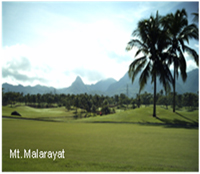
Lipa City was chosen as one of three demonstration cities of the Local-EPM Project, based on a selection process conducted by the Project Steering Committee (PSC), Inter-Agency Technical Working Group (IA-TWG) and the Project Management Coordinating Unit (PMCU). The project was launched in December 1998 after the Mayor signed the Memorandum of Agreement for the project implementation, committing to enhance the city government's capabilities by pioneering the integration of environmental planning and management within the city organizations. Whilst the Local-EPM project ended in the first quarter of 2002, a Cooperation Agreement between UN-HABITAT and The Asian Institute of Management was forged in January 2006, facilitating a second phase of support to document L-EPM experiences amongst the Lipa partners, and review opportunities to mainstream lessons learned in the Local Government Units (LGUs).
Lipa City Environmental Profile
Lipa's Environmental Profile (LEP) was produced in 1999 in both technical and popular forms, having extensively involved a wide range of stakeholders in data collection and analysis. The LEP provided baseline information to formulate sectoral plans such us the Urban Shelter Plan, and to formulate key development plans such as the Strategic Environmental Management Framework, the Environmental Action Plan, the Ten-year Strategic Solid Waste Management Plan, and the City Land Use Plan, which are in the process of formal approval.
Lipa City Consultation
The City Consultation was held in Tagaytay on November 17-19, 1999, when ninety-nine participants from various sectors participated, including heads of departments of the city government to review the LEP and prioritise the way forward, including a city "vision"; an event that was well covered by the local media.
A Consultation Organizing Team (COT) was mobilized to prepare for the consultation, who asked local resource persons to prepare proposition papers on the following priory environmental issues: land use conversion, servicing unplanned settlements, managing recreation and green space development, solid waste management, and water resource management. A paper on the institutional framework was also presented during a plenary session of the City Consultation, making various recommendations to work in a more cross-sectoral and participatory manner. Brainstorming and strategizing on each issue was done in small groups. A visioning exercise was done at the end where the participants committed themselves to support the project by signing an Environmental Manifesto. In addition, Issue Task Forces for each of the priotized issues were established as to facilitate the follow-up activities for strategy formulation and action planning.
Key Environmental Issues and Demonstration Projects
- Priority Issues
-
- Solid waste management
- Water resource management
- Managing recreation and green areas
- Sustainable land use planning
- Servicing unplanned settlements
- Demonstration Projects
-
- Community based solid waste management and clean technologies
- Watershed conservation in one upland community
- City greening
Brief Description of Demonstration Projects
Two demonstration projects were implemented by the Local-EPM project on urban community greening and community-based solid waste management. The first addressed urban blight; the second, pollution and sanitation (documentation available for uploading). In addition, a new demonstration project on Watershed Conservation in one upland community commenced implementation from 2007
* Community- based Solid Waste Management Project in Sitio San Nicolas
The community based solid waste management project called for a change in attitude among project participants, to change from indiscriminate garbage disposal to waste segregation, reduction and reuse at source. A variety of methods were employed to inform, sensitize and involve the different stakeholder groups. Awareness was raised through City to City exchanges, when visits were made to successful projects to get innovative ideas on how to introduce new or alternative approaches and technologies to reduce, reuse, recovering and recycling of solid waste.
* Community-greening project - "Barangay Environmental Rehabilitation and Development" (BERDE)
Since the improved management of recreation and green areas was identified as an important priority for the city, an issue specific working group was established after the City Consultation, which developed a strategy to better manage Lipa's green space through the community-based urban greening demo-project (BERDE), which aimed to mitigate the adverse effects of industrial development and urbanization. BERDE focused on three core components namely; 1) Information, education and mass media awareness raising, 2) capacity building, 3) plant nursery establishment and greening. The project implementation improved the barangay's coordination with local agencies like the City Agriculturist Office (CAO), as well as the community awareness on environmental concerns which broadened channels for effective participation.
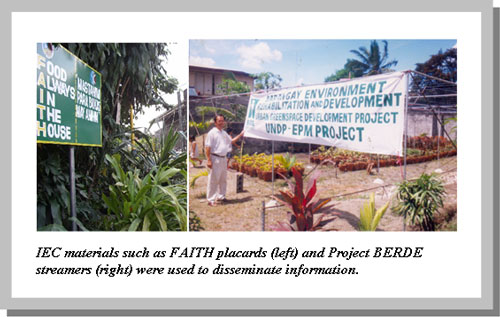
* Watershed conservation in one upland community
In 2006, building on the lessons learned during L-EPM implementation, officials from the LGU, private and public sectors and AIM carried out consultations to discuss strategies and action plans to better manage Lipa's water resources and watersheds. This resulted in the development of a new initiative to address the threat of groundwater depletion and over- extraction. The Malarayat watershed was identified as priority site for the protection strategy, supported by reforestation demonstration projects in the priority barangays of Sto Nino, Malitlit and Talisay during 2007.
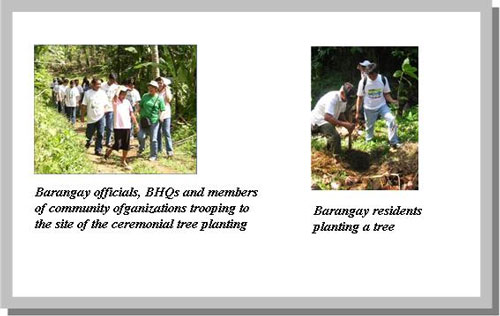
Results and Lessons Learned
Achievements
- Increased the awareness of key stakeholders, project participants and the general public on environmental issues affecting the city. This awareness was translated in the demo-communities into practical "urban home gardens" sustained through the segregation of waste at the household level.
- Created a group of EPM champions from the LGU and civil society organizations who are currently continuing the initiatives started by the L-EPM project outside the formal LGU structure and gradually institutionalising the process inside the LGU, focusing in particular on solid waste and water resources issues.
- The L-EPM process has been institutionalized in the Water District, a quasi government corporation, which is now taking the lead together with the NGO Pusod,Inc. in addressing watershed resource issue.
Lessons learned during project implementation
- Political leadership, commitment and support is critical and should be mobilized throughout. The establishment of a continuous feedback mechanism is essential to secure this support which is fundamental for institutionalization in the LGU.
- Community mobilization is a very important component for implementing sustainable demonstration projects.
- Trust and confidence among the key actors on project implementation should be seeded from the start for effective project implementation.
- Capacity building in problem analysis, strategy formulation, project implementation, confidence building, conflict management and consensus building is very necessary, and must be timely and practitioner-oriented.
Key Contacts and Associates
Pusod: http://www.pusod.org
Metro Lipa Water District: http://www.metrolipawd.com
Center for Development Management-Asian Institute of Management: http://www.aim.edu.ph
Office of the City Planning and Development Coordination Officer (CPDO) ( under development)
Office of the City Environment and Natural Resources Officer (City-ENRO) ( under development)




















